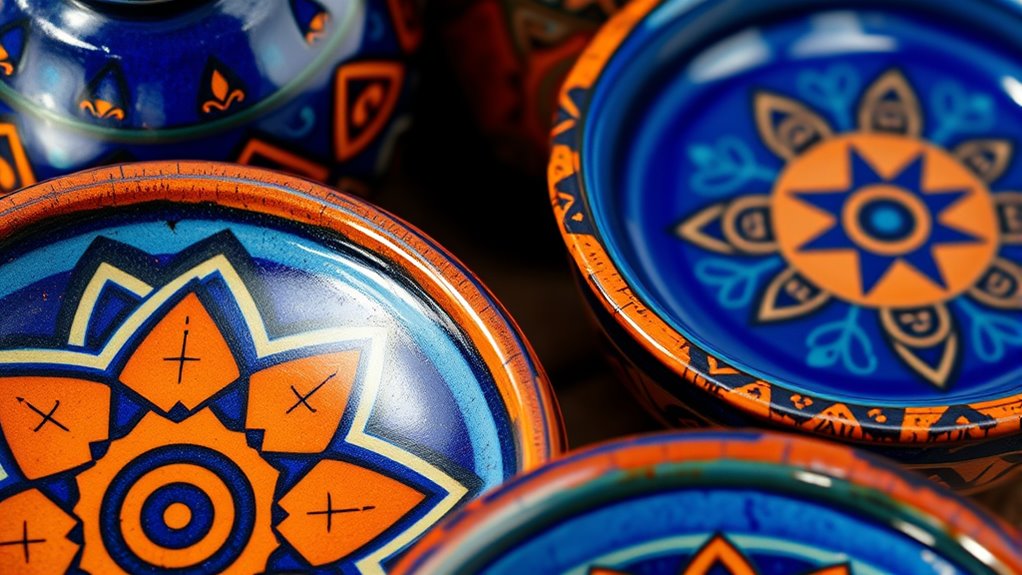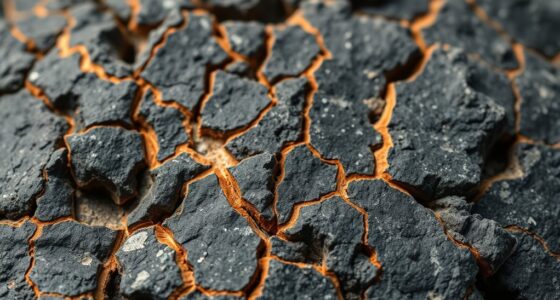Traditional Sardinian ceramics have deep roots dating back over 6,000 years, influenced by ancient civilizations like the Nuragic, Etruscans, Romans, and Byzantines. You’ll find regional styles such as decorated amphorae from South Sardinia, two-handled vessels from Oristano, and functional cookingware from Pabillonis. Craftsmen use locally sourced clays and techniques like hand modeling and wheel-throwing, blending historic motifs with modern touches. Exploring these traditions reveals a vibrant cultural identity that continues to evolve today.
Key Takeaways
- Sardinian ceramics originate over 6,000 years ago, evolving through Nuragic, Etruscan, Roman, Byzantine, and Vandal influences.
- Regional centers like Assemini, Oristano, and Dorgali are known for distinctive styles such as decorated amphorae and animal-shaped vessels.
- Traditional techniques include hand modeling, wheel-throwing, incising, and firing in wood-fired kilns, using locally sourced clay.
- Decorative motifs often feature natural, architectural, and cultural symbols with vibrant colors, reflecting regional identities.
- Contemporary artists blend traditional methods with modern styles, emphasizing preservation and regional craftsmanship.
Historical Roots and Cultural Influences
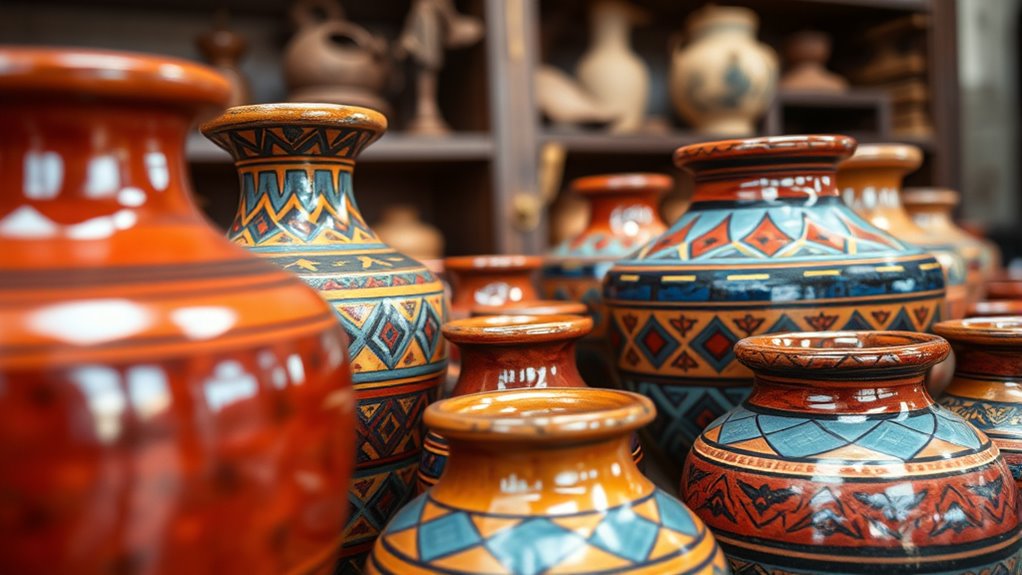
Sardinian ceramics have deep roots that span thousands of years, reflecting a rich tapestry of cultural influences. You can trace their origins back over 6,000 years to the pre-Nuragic era, when simple, practical pottery was made from natural clay. During the Nuragic civilization (circa 1800–238 BCE), craftsmanship advanced, with pottery serving essential functions like storing water and food, gradually evolving into artistic expression. Archaeological finds show continuous refinement from prehistoric times through the Nuragic period, often using locally sourced kaolin clay, which contributed to a distinctive style. Over the centuries, Sardinian ceramics absorbed influences from neighboring cultures, such as the Etruscans, Romans, Byzantines, and Vandals. These interactions enriched the island’s pottery traditions, blending local techniques with broader Mediterranean artistic and functional styles. Additionally, the use of traditional ceramic techniques has helped preserve the unique aesthetic and cultural identity of Sardinian pottery through generations.
Key Regions and Artistic Centers
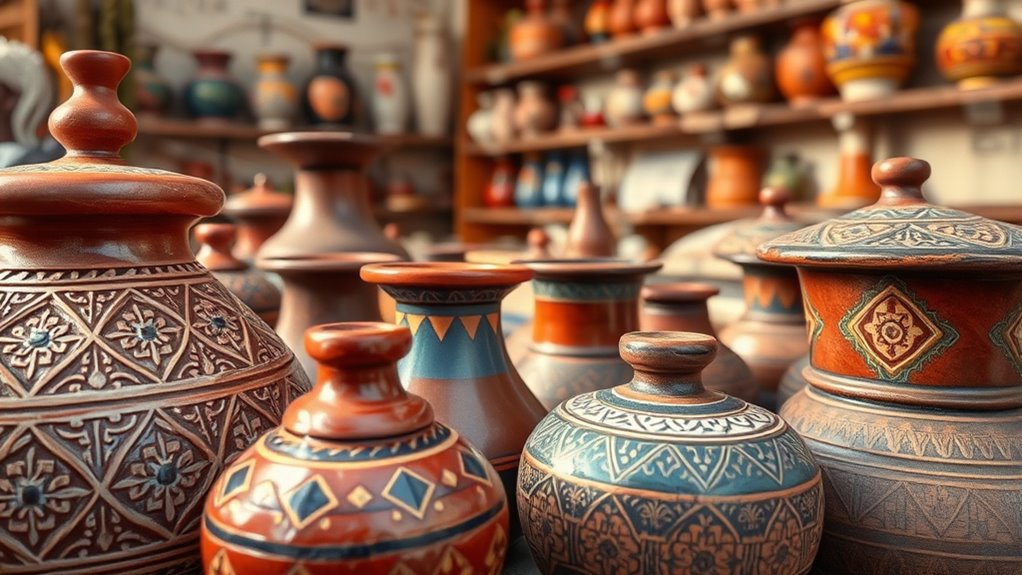
Multiple towns across Sardinia serve as essential centers for ceramic production, each contributing unique styles and techniques that define the island’s rich pottery tradition. In the south, Assemini and the Cagliari hinterland are known for their decorative amphorae and jugs, with artisan families preserving traditional craftsmanship. Oristano stands out for its famous two-handled “Figoli di Oristano” and strong artisanal presence, especially in lathe-turned terracotta with galena glazing. Pabillonis specializes in functional cooking vessels, while Dorgali combines ancient and modern techniques. In the north, Sassari and Siniscola produce distinctive pottery, including amphorae with cultural significance. Coastal centers like Cala Gonone and Villaputzu benefit from favorable climates and tourism, supporting continuous craft innovation and regional identity. Traditional Sardinian ceramics showcase a variety of regional styles and techniques that reflect the island’s diverse cultural influences.
Distinctive Forms and Decorative Motifs
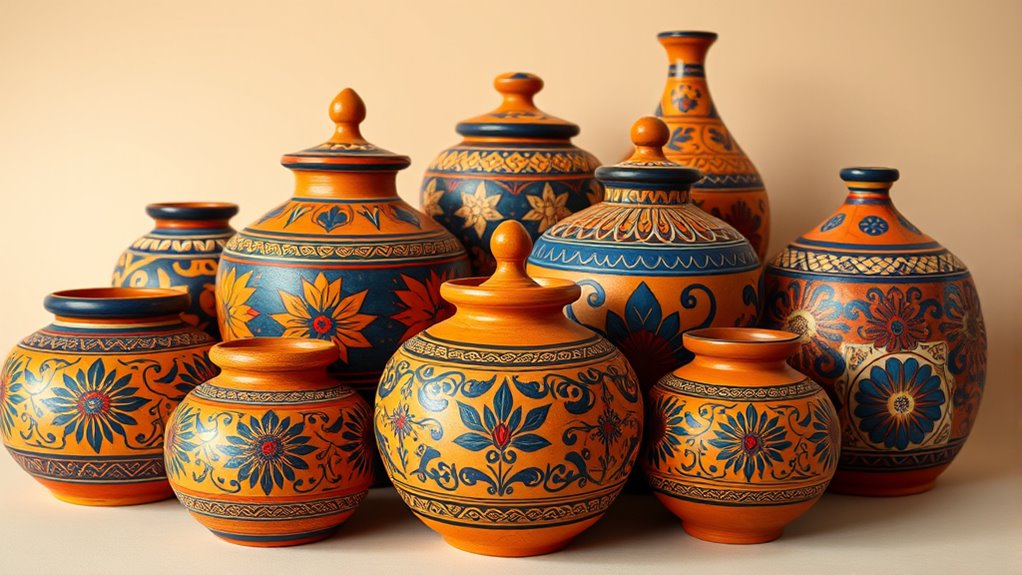
Distinctive forms and decorative motifs define the vibrant character of Sardinian ceramics, showcasing a blend of tradition and regional identity. You’ll notice two-handled jugs from Oristano, decorated with angels, reflecting Spanish influence, and animal-inspired hen-shaped vessels from Dorgali symbolize domesticity. Amphorae from Siniscola and Assemini, given as wedding gifts, feature elegant shapes tied to historic ceremonies. Everyday items like pots, pans, and water decanters vary across centers such as Cagliari and Sassari. Ornamental pieces include stylized natural elements and architectural ceramics. The motifs often incorporate bright colors, with engravings and painted details. These patterns connect past to present, preserving Sardinia’s cultural essence through symbolic designs and diverse forms, emphasizing the importance of color accuracy in maintaining their vibrant appearance.
Materials, Techniques, and Craftsmanship
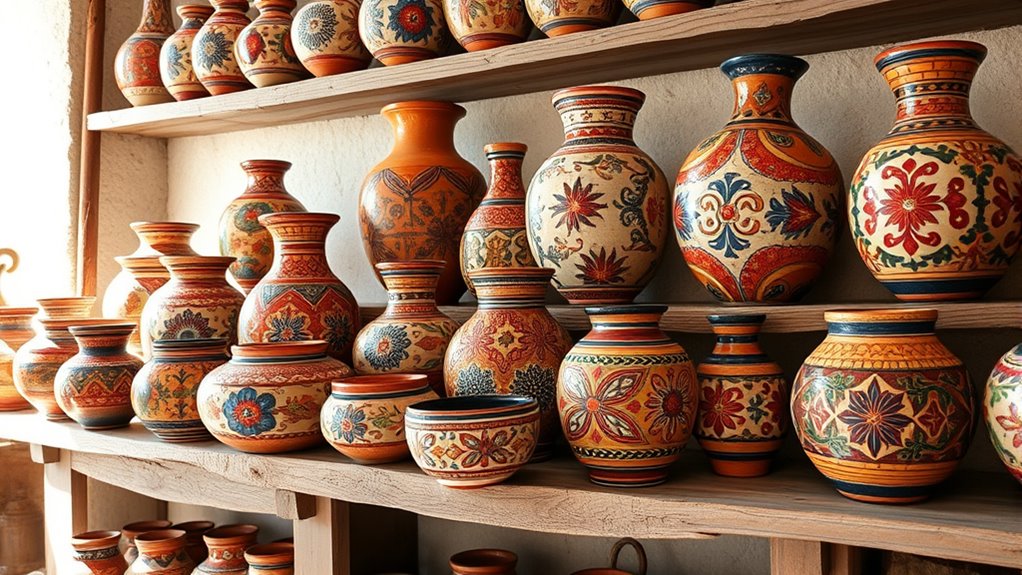
The materials used in traditional Sardinian ceramics primarily come from local sources, ensuring that artisans work with clay native to their region. You’ll find volcanic, metamorphic, and plutonic clays, often collected within 1-2 km of production sites. These raw materials are carefully cleaned and prepared, with tempering agents like volcanic glass fragments and quartz added to improve strength and texture. The process involves hand modeling or wheel-throwing, complemented by detailed decoration using incising, painting, and mineral slips. Firing takes place in wood-fired kilns, with regional variations affecting the final finish. This craftsmanship is passed down through generations, blending local geology, skill, and cultural motifs to produce unique, durable ceramics. The geological diversity of Sardinia greatly influences the variety of ceramic styles and techniques found across different regions.
Contemporary Trends and Preservation Efforts

Contemporary Sardinian ceramics are evolving by blending age-old techniques with modern artistic approaches, creating a dynamic dialogue between tradition and innovation. Influenced by 2025 design trends, they emphasize emotion, materiality, and craft. The color palette now features nature-inspired hues like terracotta reds, Mediterranean blues, and earthy greens, echoing Sardinia’s landscape. Art Deco influences reappear through geometric motifs, while sculptural forms and light-interacting finishes add a contemporary edge. Artists combine traditional methods with experimental techniques, such as hyperrealistic sculptures and narrative surfaces, expanding expressive possibilities. Preservation efforts focus on maintaining traditional skills while fostering innovation through documentation, education, and collaborations. These initiatives help Sardinian ceramics stay relevant, thriving within a global market that values authenticity, craftsmanship, and cultural storytelling. Additionally, the integration of vetted techniques ensures that craftsmanship remains high quality and sustainable for future generations.
Frequently Asked Questions
How Has Sardinian Pottery Evolved Over the Centuries?
You see that Sardinian pottery has evolved markedly over the centuries. Starting with utilitarian Bronze Age ceramics, it absorbed influences from neighboring cultures like Etruria, Spain, and France. As time went on, Roman, Phoenician, and Medieval styles added sophistication and regional uniqueness. Today, artisans blend ancient motifs with modern techniques, maintaining tradition while exploring new artistic expressions, making Sardinian pottery a rich reflection of its diverse history.
Are There Specific Symbols Unique to Sardinian Ceramics?
Sardinian ceramics showcase striking symbols like the Lapwing, representing fertility, renewal, and maternal protection. You’ll also notice geometric patterns and motifs like pomegranates, symbolizing prosperity and abundance. These symbols blend pagan and Christian influences, reflecting Sardinia’s rich cultural roots. You can spot these symbols in pottery, jewelry, and textiles, each telling a story of tradition, belief, and the island’s unique identity.
What Are the Main Challenges Facing Traditional Sardinian Pottery Today?
You face several challenges in keeping traditional Sardinian pottery alive. Market competition from mass-produced items cuts into demand, and rising costs make it hard to stay profitable. Younger generations lack interest, and many master artisans are aging without apprentices. Additionally, maintaining authenticity is tough with imitation and commercial pressures. Limited support, funding, and access to modern tools hinder innovation, making it difficult to sustain this cultural craft for future generations.
Can Tourists Participate in Sardinian Ceramic Workshops?
Imagine diving into a world where your hands shape history—yes, tourists can participate in Sardinian ceramic workshops. You’ll get to create your own bowls or mugs, learning ancient techniques in a lively, cultural setting. With personalized guidance, all materials provided, and authentic Sardinian treats, you’re invited to craft a piece of the island’s soul. No experience needed—just bring your enthusiasm and a willingness to get a little messy!
How Do Sardinian Ceramics Influence Contemporary Italian Design?
You see, Sardinian ceramics influence contemporary Italian design by inspiring artists to incorporate regional motifs like fish, birds, and vegetables, adding unique, rustic charm. You’ll notice their handcrafted textures and traditional techniques, emphasizing authenticity and materiality. Designers use these elements to create diverse, culturally rich pieces that stand out in the market. By blending old and new, Sardinian styles help you celebrate regional identity while fostering innovation in modern Italian ceramics.
Conclusion
As you explore Sardinian ceramics, you’ll discover a rich blend of history and artistry that dates back centuries. Did you know that over 80% of traditional ceramics are still handcrafted using ancient techniques? This dedication keeps the cultural essence alive while adapting to modern trends. By appreciating these timeless styles, you help preserve a crucial part of Sardinia’s heritage, ensuring future generations continue to enjoy and learn from these beautiful, enduring crafts.
